The Life Sciences Analytics Market is estimated to be valued at USD 16.7 billion in 2025 and is projected to reach USD 39.8 billion by 2035, registering a compound annual growth rate (CAGR) of 9.1% over the forecast period.
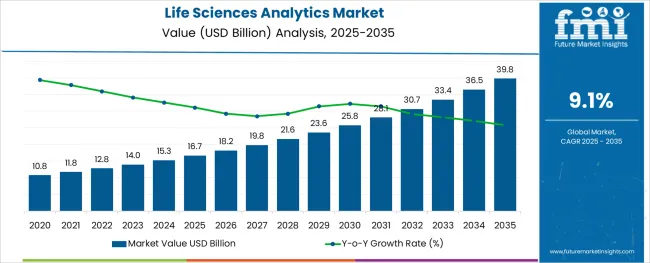
The life sciences analytics market is witnessing sustained growth driven by the increasing need for advanced data-driven insights to support decision-making in clinical development, regulatory compliance, commercial operations, and patient engagement. Growing complexities in clinical trials, stringent regulatory environments, and the rise of precision medicine are pushing life sciences companies to adopt analytics solutions that enhance operational efficiency and reduce time-to-market for therapeutics.
The current market scenario reflects an intensified focus on real-world evidence generation, predictive analytics, and AI-integrated platforms, particularly as pharmaceutical and biotechnology firms aim to optimize product pipelines and improve patient outcomes. Future market outlook remains positive, with substantial investments anticipated in cloud-based and AI-enabled analytics solutions that support decentralized trials and real-time data processing.
The integration of analytics in drug discovery, market access strategies, and personalized care management is expected to reshape industry practices, while ongoing collaborations between healthcare providers, payers, and life sciences companies are set to accelerate the adoption of data-centric models. This continuous evolution positions the market for consistent expansion, supported by technological innovation, regulatory reforms, and the growing emphasis on patient-centric healthcare delivery.
The market is segmented by Component, Type, Application, and End-user and region. By Component, the market is divided into Software and Service. In terms of Type, the market is classified into Descriptive Analytics, Predictive Analytics, and Prescriptive Analytics. Based on Application, the market is segmented into Clinical and Preclinical Trials, Regulatory Compliance, Research and Development, Sales and Marketing, and Supply Chain Management. By End-user, the market is divided into Medical Device Companies, Laboratory and Pharmaceutical Companies, and Biomedical Companies. Regionally, the market is classified into North America, Latin America, Western Europe, Eastern Europe, Balkan & Baltic Countries, Russia & Belarus, Central Asia, East Asia, South Asia & Pacific, and the Middle East & Africa.
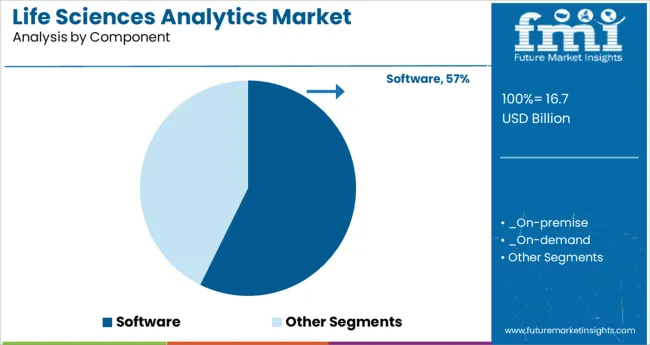
The software segment accounted for approximately 57.3% of the total life sciences analytics market share, maintaining its position as the leading component category. The segment’s growth has been propelled by the rising demand for scalable, interoperable, and AI-powered analytics platforms that enable life sciences companies to efficiently manage complex datasets and derive actionable insights.
Software solutions have been widely deployed across clinical development, regulatory reporting, and commercial operations, offering flexibility and customization based on organizational needs. Additionally, the increasing preference for cloud-based analytics tools has enhanced real-time data accessibility and collaborative decision-making, particularly in multinational clinical trials and pharmacovigilance programs.
Leading pharmaceutical and biotechnology firms continue to invest in advanced analytics applications for forecasting, risk management, and portfolio optimization. The segment is expected to maintain its dominant position, driven by continuous product innovation, integration of AI and machine learning capabilities, and strategic partnerships aimed at expanding data interoperability and precision analytics capabilities across the life sciences ecosystem.
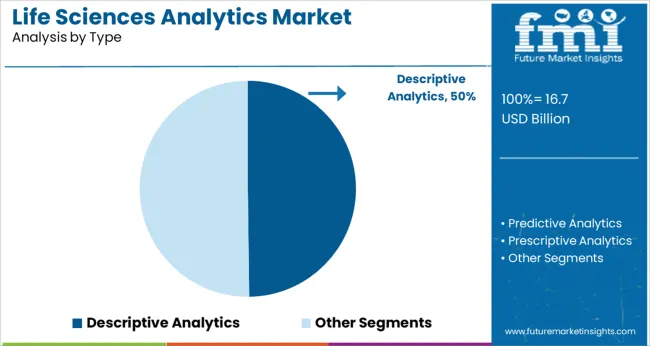
Within the type category, the descriptive analytics segment led with a 49.8% market share, reflecting its foundational role in enabling life sciences organizations to analyze historical data and monitor key performance indicators across clinical, operational, and commercial functions. This segment has consistently remained a critical component of enterprise analytics strategies, offering clarity on past trends, operational bottlenecks, and market dynamics.
The widespread adoption of descriptive analytics tools has been driven by their ease of integration with existing data infrastructures and their ability to generate straightforward, actionable reports that support regulatory submissions, safety monitoring, and performance benchmarking. As the life sciences sector increasingly relies on data-driven insights to improve decision-making and resource allocation, descriptive analytics solutions are being enhanced with visualization tools and dashboard functionalities to improve user engagement and reporting efficiency.
Future growth for this segment will likely be sustained by the ongoing need for structured reporting, regulatory documentation, and operational transparency in a progressively digital and value-based healthcare environment.
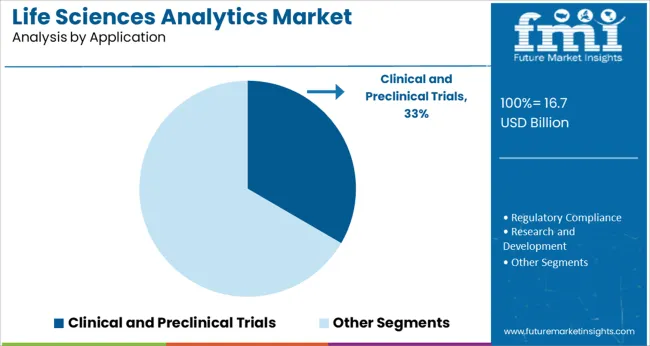
The clinical and preclinical trials segment commanded a significant 33.4% market share, establishing itself as the primary application area within the life sciences analytics market. The segment’s leadership has been attributed to the growing complexities and costs associated with drug development, which have necessitated the adoption of analytics tools to optimize trial design, patient recruitment, risk assessment, and outcome analysis.
The increased emphasis on decentralized and adaptive trial models, accelerated by global health crises and regulatory flexibility, has further fueled demand for advanced analytics platforms capable of handling diverse and voluminous clinical data. Life sciences companies and contract research organizations are leveraging analytics to improve trial efficiency, reduce drop-out rates, and enhance safety monitoring through real-time data insights.
Moreover, the integration of real-world evidence and predictive analytics in clinical decision-making has strengthened the segment’s growth trajectory. Future expansion is expected as regulatory bodies encourage data-driven submissions and life sciences companies prioritize digital transformation strategies to expedite clinical development timelines and improve patient outcomes.
The below table presents the expected CAGR for the global life sciences analytics market over several semi-annual periods spanning from 2025 to 2035. In the first half (H1) of the year from 2025 to 2035, the business is predicted to surge at a CAGR of 8.8%, followed by a slightly higher growth rate of 8.9% in the second half (H2) of the same year.
| Particular | Value CAGR |
|---|---|
| H1 | 8.8% (2025 to 2035) |
| H2 | 8.9% (2025 to 2035) |
| H1 | 9.1% (2025 to 2035) |
| H2 | 9.5% (2025 to 2035) |
Moving into the subsequent period, from H1 2025 to H2 2035, the CAGR is projected to increase slightly to 9.1% in the first half and remain relatively moderate at 9.5% in the second half. In the first half (H1) the market witnessed a decrease of 30 BPS while in the second half (H2), the market witnessed an increase of 60 BPS.
Technological Advancements in Data Analytics drive Industry Growth
Technological enhancements in analytics tools and software spur developments in theis industry. Artificial intelligence, machine learning, and big data analytics have transformed the scenario. Life sciences organizations manage and analyses complicated biological data with ongoing developments.
Advanced tools offer faster and more precise analysis. This precision results in better decisions in drug research, clinical trials, and patient care. Enhanced data integration and visualization technologies enable researchers to find previously undetected patterns and connections.
Increasing Adoption of Tailored Medicine Benefits Business
Personalized medicine necessitates the integration and analysis of massive volumes of genetic, clinical, and environmental data to adapt therapies to individual patients. Advanced analytics helps in interpretation of this data. It enables healthcare providers to create more effective and focused medications. This method improves patient outcomes and optimizes resource utilization, lowering healthcare costs.
Investments in Healthcare IT enhances Life Science Analytics Market
Substantial upsurge in investments in healthcare IT infrastructure bodes well with expansion of the life science analytics industry. Governments, business organizations, and healthcare providers are progressively investing in development and implementation of advanced analytics systems.
These efforts are intend to improve data management. They also increase interoperability between healthcare systems and promote regulatory compliance. Use of advanced analytics systems is growing, allowing life sciences organizations to better harness data for research and development and clinical decision-making.
Data Privacy and Security Concerns obstruct the Growth of Life sciences Analytics Market
The life science analytics business confronts hurdles in data privacy and security. Nature of healthcare data needs safeguards against breaches and unauthorized access. Regulatory frameworks like GDPR and HIPAA set stringent compliance standards that can be difficult. These services can be expensive to meet.
Growing number of cyberattacks on healthcare systems hamper security of data analytics platforms. These challenges impede the adoption of analytics solutions. Organizations may be concerned about the legal and financial consequences of data breaches.
The global life sciences analytics industry was outline at a CAGR of 11.7% from 2020 to 2025. The industry showed positive findings as it reached a value of USD 16.7.0 billion in 2025 from USD 10.8 billion in 2020.
Advances in data analytics technologies, greater acceptance of personalized medication, and rising investments in healthcare IT infrastructure propelled success of this firm. During this time, the market experienced increasing integration of AI and machine learning. This improved data processing skills and outcomes in drug research and clinical trials.
Demand for life sciences analytics is expect to grow even more rapidly in foreseeable times. Continuous technology innovation, spread of precision medicine, and greater dependence on data-driven decision-making in healthcare will prove propulsion.
Plus, growth of IoT and wearable devices is likely to upsurge data generation, demanding even powerful analytics solutions. Data privacy and security issues will remain a key problem. This issue potentially influence the rate of adoption. The industry is foreseen to skyrocket driven by the continual advancement of analytics capabilities and the global transformation of healthcare systems.
Companies in the tier 1 are the leading players in the life science analytics market. They have a noteworthy global presence, widespread client bases, and high revenue streams. These companies often lead the market in terms of innovations, wide-ranging solutions, and strategic partnerships. They have resources to invest in leading technology and research. This allows them to offer innovative analytics capabilities. Companies within tier 1 are Accenture Plc., IBM Corporation, Oracle Corporation, IQVIA (Quintiles, Inc.), SAS Institute Inc. and SAP SE.
Tier 2 companies have a significant presence and influence in the life science analytics market but do not match the extensive reach or effect of tier 1 companies. They are often robust regional players or have a specific focus within the industry. These companies provide substantial value through their expertise and tailor-made solutions but may not have the same level of resources or global footprint as Tier 1 companies. Prominent companies in tier 2 include Cognizant Technology Solutions Corporation, Wipro Limited, Take Solutions, Inc. and Scio Health Analytics.
Tier 3 companies are emergent players or those with a niche focus in the life science analytics market. They usually have a lesser existence and may be newer entrants to the industry. These companies are often innovative, carving out specific areas of expertise within the broader market.
While they may not yet compete with the larger firms in terms of scale, they provide valuable and particular services that cater to specific needs. Tier 3, within this context, is recognized as an unorganized market, representing a sector characterized by a lack of extensive structure and formalization when compared to organized competitors. This tier includes the MaxisIT Inc. and Scio Health Analytics
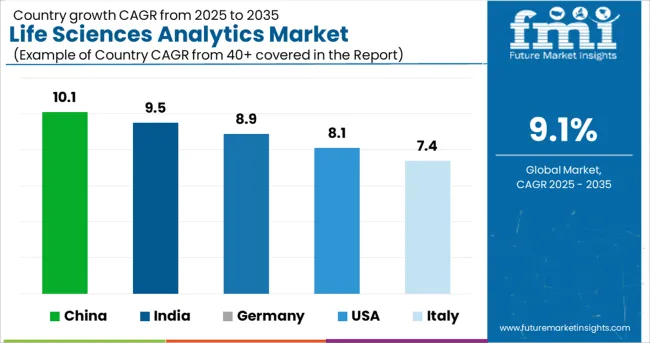
| Countries | Value CAGR (2025 to 2035) |
|---|---|
| China | 10.1% |
| India | 9.5% |
| Germany | 8.9% |
| USA | 8.1% |
| Italy | 7.4% |
The section below covers the industry analysis for the life sciences analytics market for different countries. The demand analysis on key countries in several countries of the globe, including the United States, Germany, France, China and India are mention.
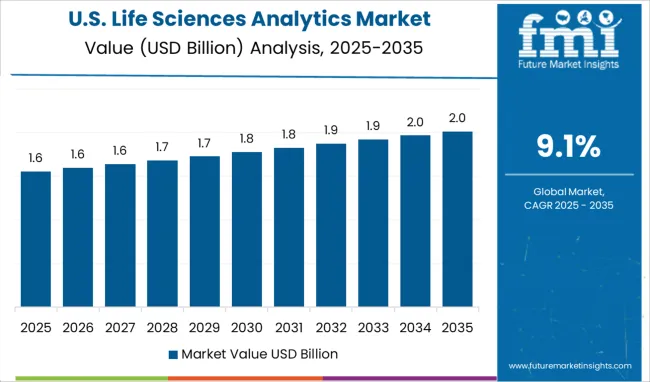
The life science analytics industry in the United States is estimate to register a CAGR of 8.1% from 2025 to 2035.
Well-equipped infrastructure and leadership in technological improvements economically profit the United States. The United States boasts a well-established healthcare system and wide research facilities. They own high concentration of pharmaceutical and biotech companies.
Extensive funding for healthcare research and favorable regulatory frameworks boost the business. Adoption of big data, artificial intelligence, and machine learning in healthcare is widespread. This drives innovation in personalized medicine, predictive analytics, and efficient drug development. Collaborations between academia, industry, and technology firms enhance capabilities and adoption of life science analytics across the country.
South Asia and Pacific, spearheaded by the India currently holds around 30.8% share of the life sciences analytics. The industry is set to cover a CAGR of 9.5% through 2035 with mass development and growing IT sector.
India is witnessing extensive growth in the life science analytics market due to its increasing healthcare sector and renowned IT capability. The country has a huge and diverse patient population, making it a valued source of healthcare data for analytics applications.
India's IT industry is one of the world's biggest, providing the required technological support and innovations for life science analytics. Indian government initiatives like "Digital India" and increased investment in healthcare infrastructure are further driving the adoption of analytics. Furthermore, India's economical clinical trials and pharmaceutical manufacturing abilities attract worldwide companies, enhancing the demand for advanced analytics to improve proficiency and results.
The Chinese industry is set to cover an impressive CAGR of 10.1% from 2025 to 2035 in life science analytics.
Solid financial growth and efforts to update its healthcare systems have triggered their growth scale. The Chinese government is investing in healthcare infrastructure, research, and technology adoption. This have proven propulsion.
Chinese government Initiatives like "Made in China 2025" have grown globally in this firm. They are aiming to enhance innovation and self-reliance in high-tech sectors worldwide. Growing prevalence of chronic diseases with growing middle class propel demand for innovative healthcare solutions.
The section contains information about the leading segments in the industry. By component, the segment is estimate to grow at a CAGR of 10.6% through 2035. Also, the research and development segment is projected to expand at a CAGR of 10.1% during forecasted period.
| Component | Solution |
|---|---|
| Value Share (2025) | 56.8% |
The solution segment dominates the landscape in terms of revenue, accounting for almost 56.8% of the share in 2025.
Solutions segment holds the dominating share driven by the increasing demand for advanced analytics tools that enable data integration, management across many life sciences applications.
The efficiency of research and development, quality of patient conclusions, and regulatory compliance all depend on these solutions. They comprise software platforms and apps designed for clinical data analysis, predictive analytics, and real-world evidence generation.
Accelerating adoption of cloud-based analytics solutions and developments in AI and ML have uplift the segment’s position in this industry. As businesses look to use advanced analytics tools to extract insights from large and complicated datasets requirements have increased.
| Application | Research and Development |
|---|---|
| CAGR (2025 to 2035) | 10.1% |
Research and development segment within the life science analytics market is predictable to experience strong growth, with a CAGR of 10.1% during the forecasted period. This growth is determined by the growing acceptance of advanced analytics to streamline the drug discovery procedure, improve clinical trial efficiency, and accelerate the development of new therapies.
The combination of big data and AI technologies is transforming research and development by allowing more accurate estimates, tailored medicines, and lucrative solutions. Also, the mounting bulk size of data is pushing medicinal and biotech vendors to leverage analytics. This trend highlights critical role of analytics in driving innovation and improving outcomes in life sciences research.
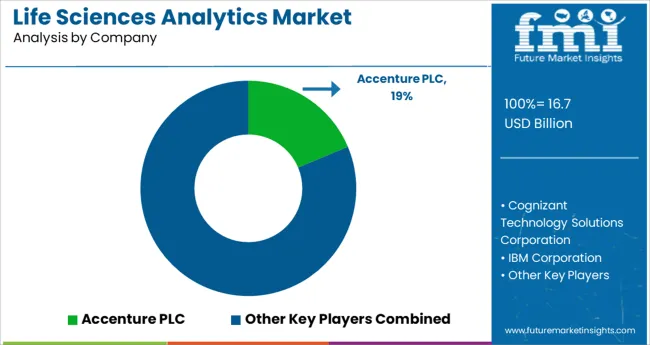
Kea players in the life sciences analytics market are investing in innovations and modernizations of tools while also forming collaborations. Key life sciences analytics vendors have also been acquiring small and medium based vendors to expand their footprint and penetrate the market in multiple regions.
Recent Industry Developments in Life Sciences Analytics Market
The industry is divided into solution and services.
The segment is segregate into clinical and preclinical trials, regulatory compliance, research and development, sales and marketing and supply chain management.
The device type is classified as descriptive, predictive and prescriptive.
The sector is fractioned into biomedical companies, laboratory, pharmaceuticals, and medical device companies.
A regional analysis has been carried out in key countries of North America, Latin America, Asia Pacific, Middle East and Africa (MEA), and Europe.
The global life sciences analytics market is estimated to be valued at USD 16.7 billion in 2025.
It is projected to reach USD 39.8 billion by 2035.
The market is expected to grow at a 9.1% CAGR between 2025 and 2035.
The key product types are software, _on-premise, _on-demand, service, _professional and _managed.
descriptive analytics segment is expected to dominate with a 49.8% industry share in 2025.






Full Research Suite comprises of:
Market outlook & trends analysis
Interviews & case studies
Strategic recommendations
Vendor profiles & capabilities analysis
5-year forecasts
8 regions and 60+ country-level data splits
Market segment data splits
12 months of continuous data updates
DELIVERED AS:
PDF EXCEL ONLINE
Life Support Systems Market Size and Share Forecast Outlook 2025 to 2035
Life Science Software Market Size and Share Forecast Outlook 2025 to 2035
Lifestyle Concierge Services Market Size and Share Forecast Outlook 2025 to 2035
Life Science Multichannel Campaign Management Market Size and Share Forecast Outlook 2025 to 2035
Life Science Logistics Market Analysis - Size, Share, and Forecast Outlook 2025 to 2035
Lifestyle Sneakers Industry Analysis in United Kingdom Growth, Trends and Forecast from 2025 to 2035
Life Science and Chemical Instruments Market Analysis - Growth & Forecast 2024 to 2034
Life Sciences Next-generation Customer Engagement Platforms Market Size and Share Forecast Outlook 2025 to 2035
Wildlife Tourism Market Size and Share Forecast Outlook 2025 to 2035
Wildlife Health Market Size and Share Forecast Outlook 2025 to 2035
Early Life Nutrition Market Size and Share Forecast Outlook 2025 to 2035
Plant life Extensions (PLEX) and Plant Life Management (PLIM) for Nuclear Reactors Market
Marine Life Raft Market Size and Share Forecast Outlook 2025 to 2035
Second-Life Battery Storage Systems Market Size and Share Forecast Outlook 2025 to 2035
Service Lifecycle Management Application Market Size and Share Forecast Outlook 2025 to 2035
Product Life-Cycle Management (PLM) IT Market Size and Share Forecast Outlook 2025 to 2035
Aviation Life Rafts Market Size and Share Forecast Outlook 2025 to 2035
Contract Lifecycle Management Market Growth – Trends & Forecast 2025 to 2035
Lymphoproliferative Disorder Treatment Market
Agile Application Life-Cycle Management Market Size and Share Forecast Outlook 2025 to 2035

Thank you!
You will receive an email from our Business Development Manager. Please be sure to check your SPAM/JUNK folder too.
Chat With
MaRIA